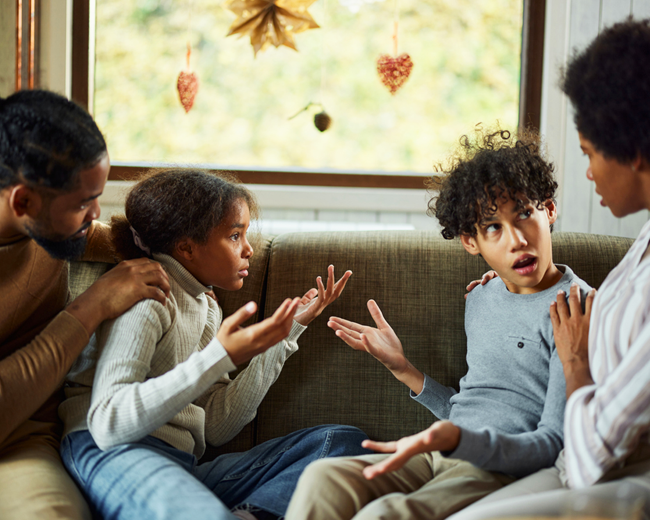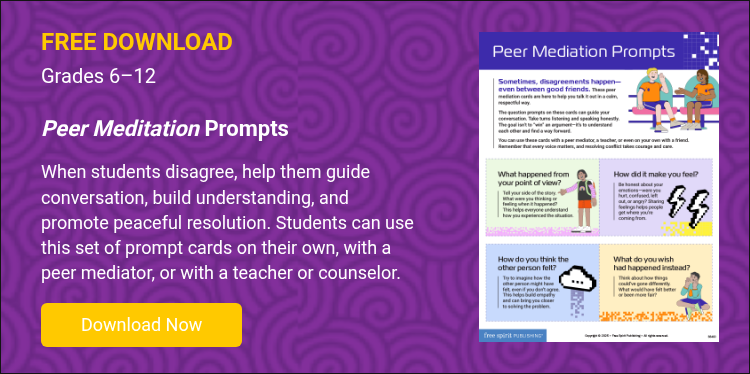Conflict is a normal part of growing up—and learning how to manage it is essential. In this article, you’ll learn practical ways to help students understand the roots of disagreements, respond with empathy and respect, and use healthy communication tools to solve problems. From classroom activities to coaching moments, you’ll discover how to teach your students to handle conflict confidently and kindly and to disagree respectfully and productively with each other.
Helping Students Resolve Disagreements with Friends
As kids mature, the importance of friendship groups increases. Kids with close friends tend to be better adjusted. The support that comes from friends can have a protective effect against the stresses kids deal with, both in and outside of school. So when conflicts arise in friendship groups, they can create significant emotional problems for kids. Unresolved disagreements can lead to being rejected or ostracized. Bullying can also result. Left unresolved, social conflicts at school can lead to a drop in academic performance.
Since many problems with friends arise in school, educators are in a unique position not only to intervene when needed, but also to teach kids conflict resolution skills that will be useful long after they leave school.
Understanding the Causes of Disagreements
Common Triggers for Conflict
According to The Kids' Guide to Working Out Conflicts by Naomi Drew, boys and girls tend to have different causes for disagreements among peers. For girls, these include gossip or rumors, secrets, feeling jealous or left out, saying mean things about someone to others, and boyfriends. For boys, common conflict starters include who is right or wrong, bragging, the rules of games, and insults or name-calling. The common theme in these triggers is hurt feelings.
The Impact of Social Media
Social media contributes significantly to school-based conflicts. For example, if one person in a friend group sees that the group has gotten together but was not invited or included, hurt feelings result. Being criticized or made fun of can be worse when social media are involved, since many more people can see or comment on postings. The immediacy of social media also makes it harder to stop the conflict from spreading quickly.
Teaching Students to Disagree Respectfully and Productively

One of the most valuable skills educators can teach is how to disagree respectfully and disagree productively. These skills help students manage emotions, maintain friendships, and collaborate effectively in academics and life.
What It Means to Disagree Respectfully
Disagreeing respectfully means listening without interrupting, using polite language, and showing empathy—even when opinions differ. It is possible to hold a different viewpoint without putting down or invalidating someone else's experience.
The Power of Disagreeing Productively
When students learn to disagree productively, they begin to view conflicts as opportunities for growth and learning. Productive disagreement involves using critical thinking, asking clarifying questions, and working toward solutions together. Instead of trying to "win" an argument, students should aim to understand and solve problems.
Prevention Strategies
Incorporating Conflict Resolution into the Curriculum
One way to prevent problems from developing in the first place is to teach appropriate conflict resolution skills as part of the school curriculum. The Ophelia Project offers a friendship curriculum for second and third graders that includes a section on conflict resolution.
Building Empathy and Communication Skills
School counselors can give lessons to each classroom, presenting possible scenarios for when conflict may occur and seeking the input of students on what things lead to conflict and how they might resolve the problem. Lessons on building empathy can also help prevent disagreements from becoming more hurtful and leading to longer-lasting problems.
To support students, consider implementing the following activities:
- Role-playing scenarios where students practice using "I-messages" and active listening.
- Class discussions about respectful disagreement using age-appropriate literature.
- Journaling prompts asking students to reflect on a time they disagreed with someone and how they handled it.
Monitoring Student Interactions
Sometimes we need to more closely monitor student interactions. For example, during recess, lunch, and locker room times, adults should mingle among students and observe how they are getting along. Be prepared to intervene as needed. Proximity can be a good deterrent to inappropriate behavior. Simply walking closer to the students involved in a disagreement can remind them to behave appropriately. Spending time with students also allows staff to identify instigators more easily rather than relying on students to report problems, which they are often hesitant to do.
Steps for Intervention
Encouraging Student-Led Solutions
As much as possible, give students leeway to resolve problems on their own. Often, disagreements are minor, and even though feelings may be hurt in the short term, most kids return to being friends fairly quickly. Learning to resolve conflicts in this way is an important skill to master.
When problems persist, however, give students the option to request a meeting with a school counselor to address the problem.
Coaching Through Conflict
When educators intervene, the first step is to ask the students what they have tried in order to solve the problem, whether or not that worked, and what else they could do to solve the problem. This promotes a sense of mastery and competence. Helping students brainstorm solutions not only empowers them, but also makes it more likely that they will actually try the solutions rather than simply nod when yet another adult tells them what to do.
Think of it as an opportunity to teach a skill rather than simply solve the problem for them. You are coaching them by asking them to think differently about the problem and possible solutions. Model how to disagree respectfully and how to explore compromises that help both parties feel heard.
Peer Mediation and Student Empowerment
Some schools have trained peer counselors or peer mediators who are available to help. This gives kids a sense of importance and emphasizes student-led solutions to problems. A number of online resources are available to help schools develop peer mediation programs:
Ideally, all students should receive training in peer mediation. The better equipped students are to manage their conflicts on their own, the more time and resources can be spent on instruction.
Teaching Practical Communication Tools
Using I-Messages
Teaching basic communication skills is another way to facilitate conflict resolution. For example, teaching kids to use "I-messages" when expressing their frustrations rather than blaming others for a problem can be very useful. Examples:
- "I feel excluded when you don’t make room for me at lunch."
- "I felt hurt when you made fun of me in front of everyone."
These types of statements model respectful disagreement and invite others into a productive dialogue.
Sentence Starters for Productive Dialogue
Provide students with simple sentence starters they can use when resolving conflict:
- "I see it differently because..."
- "Can we find a way to fix this together?"
- "Let’s take turns sharing how we feel."
These tools support a culture of disagreeing productively and help students de-escalate tension.
Partnering with Parents When Necessary
While most kid conflicts do not necessitate a call or an email home to parents, in some cases, contacting parents may be necessary. For example, if you believe bullying is involved, this is a more serious issue, and contacting parents is wise. It’s often helpful to encourage kids to share with their parents.
A Lifelong Skill
Learning to handle conflict is a life skill that everyone needs to learn. By teaching students how to disagree respectfully and disagree productively, and assisting them when they need extra support, school can be a more positive environment for students as well as educators. These lessons not only protect friendships but also prepare kids for future personal and professional success.
Teaching students how to navigate conflict isn’t just about today’s friendship disagreement—it’s also about building tomorrow’s leaders. The approaches suggested in this article will empower kids to maintain healthy relationships and to build emotional intelligence. Keep modeling, keep coaching, and keep the conversation going, and your students will learn skills they’ll use for life.

